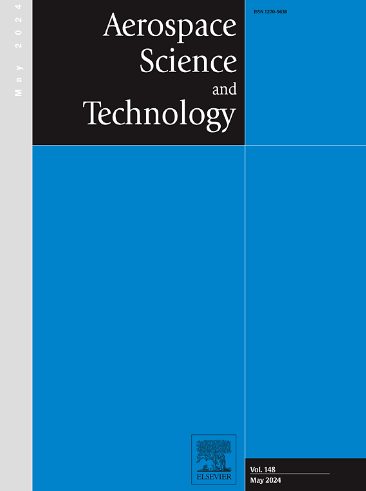具有非线性能量沉降的飞机机翼的气动弹性
IF 5
1区 工程技术
Q1 ENGINEERING, AEROSPACE
引用次数: 0
摘要
本文研究了非线性能量汇对增强飞机机翼气动弹性稳定性和失稳后响应的有效性。机翼在弯曲和扭转时有两个自由度,并使用带有硬化非线性的扩展欧拉-伯努利梁理论进行建模。机翼内部嵌入了一个沿翼展分布的非线性能量吸收器(NES)。利用瓦格纳指示升力模型模拟了机翼附着的非稳定气动载荷。机翼的结构动力学是利用扩展汉密尔顿原理推导出来的,并采用伽勒金方法对其进行离散化处理。NES 质量通过线性阻尼器和具有立方刚度非线性的非线性弹簧与翼展相连。然后将耦合气动弹性方程转换到状态空间。然后,通过数值积分解析机翼的弯曲和扭转响应,研究嵌入式 NES 的跨度和弦向位置对抑制扑翼和增强失稳响应的影响。结果表明,当 NES 位于翼尖时,其效率最高,对刚度的变化最为敏感。对于给定的弦向位置,发现 NES 最有效的流速范围是存在的,而减少弦向偏移会降低峰值效率范围的速度,并使其更接近扑翼速度。此外,增大 NES 的刚度系数还能提高设备在紧接扑翼后区域的效率。我们提出了两个接近最佳的 NES 装置,其质量比分别为 1%(位于翼尖)和 2.5%(位于 75% 跨度)。这两种装置都将扑翼速度提高了 5%,并将扑翼后响应分别降低了 64.5% 和 59.2%。本文章由计算机程序翻译,如有差异,请以英文原文为准。
Aeroelasticity of an aircraft wing with nonlinear energy sink
In this paper, the effectiveness of nonlinear energy sinks on enhancing aeroelastic stability and post-instability response of aircraft wings is investigated. The wing has two degrees of freedom in bending and torsion, and is modelled using an extended Euler-Bernoulli beam theory with hardening nonlinearity. A Nonlinear Energy Sink (NES) absorber is embedded inside the wing distributed along the wing span. The wing attached unsteady aerodynamic loads are simulated using the Wagner's indicial lift model. The structural dynamics of the wing are derived using Extended Hamilton's Principle and it is discretised using Galerkin's method. The NES mass is connected to the wing spar through a linear damper and nonlinear spring with a cubic stiffness nonlinearity. The coupled aeroelastic equations are then transformed to state space. Then, integrated numerically to resolve the bending and torsional response of the wing to study the impact of spanwise and chordwise positions of the embedded NES on flutter suppression and instability response enhancement. The results demonstrate that the NES is most efficient and is most sensitive to changes in the stiffness when placed at the wingtip. For a given chordwise location, it is found that there is a range of flow speeds over which the NES is most effective and reducing the chordwise offset lowers the speed of the peak efficiency range and moves it closer to the flutter speed. In addition, increasing the stiffness coefficient of the NES improves the efficiency of the device in the immediate post-flutter region. Two near optimum NES devices are proposed with a mass ratios of 1% (located at the wingtip) and 2.5% (located at 75% span). Both of these improve the flutter speed by 5%, and reduce the post-flutter response by 64.5% and 59.2%, respectively.
求助全文
通过发布文献求助,成功后即可免费获取论文全文。
去求助
来源期刊

Aerospace Science and Technology
工程技术-工程:宇航
CiteScore
10.30
自引率
28.60%
发文量
654
审稿时长
54 days
期刊介绍:
Aerospace Science and Technology publishes articles of outstanding scientific quality. Each article is reviewed by two referees. The journal welcomes papers from a wide range of countries. This journal publishes original papers, review articles and short communications related to all fields of aerospace research, fundamental and applied, potential applications of which are clearly related to:
• The design and the manufacture of aircraft, helicopters, missiles, launchers and satellites
• The control of their environment
• The study of various systems they are involved in, as supports or as targets.
Authors are invited to submit papers on new advances in the following topics to aerospace applications:
• Fluid dynamics
• Energetics and propulsion
• Materials and structures
• Flight mechanics
• Navigation, guidance and control
• Acoustics
• Optics
• Electromagnetism and radar
• Signal and image processing
• Information processing
• Data fusion
• Decision aid
• Human behaviour
• Robotics and intelligent systems
• Complex system engineering.
Etc.
 求助内容:
求助内容: 应助结果提醒方式:
应助结果提醒方式:


